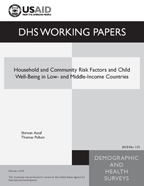
Abstract:
This report focuses on the well-being of children age 0-17 using 10 outcomes in four domains: nutrition, health care, schooling, and child protection. The data used in the analysis were obtained from recent surveys
conducted by The Demographic and Health Surveys Program, one survey in each of 30 countries selected on the basis of USAID priorities or low levels of the Human Development Index. The analysis describes the relationship between each outcome and risk factors at the levels of the child, household, and sample cluster. The working hypothesis, based on empirical generalizations found in the literature, was that risk factors would correspond with negative outcomes for all indicators in all countries. However, to the contrary, it is found that the effect of most risk factors cannot be generalized across all outcomes or all countries. For example, the effect of household structure, represented by the presence of biological parents and the relationship of the child to the household head, tends to be stronger for the child protection and schooling outcomes than for other outcomes, but this relationship is not consistent across all countries. The index of household crowding—the number of household members per room—has a strong association with most outcomes across all the surveys, but this generalization does not hold for schooling and birth registration. The analysis implies that the impact on child outcomes of household structure and other household-level or community-level variables can vary, sometimes substantially, across countries.
 Household and Community Risk Factors and Child Well-Being in Low- and Middle-Income Countries (PDF, 7029K)
Household and Community Risk Factors and Child Well-Being in Low- and Middle-Income Countries (PDF, 7029K)
